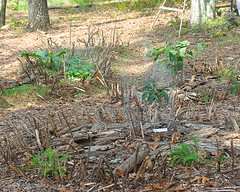Fertility in progress...
 This has been my first summer garden with chickens and those that have followed along know the various issues I’ve had ranging from the size of the flock being too large as well as issues with free ranging chickens doing a bit too much damage to seedlings. Throughout this summer I’ve been experimenting, observing and thinking. Things improved greatly when we cut the flock size down from 25 to 15, the latter being much closer to my original plan. As of a month or so ago I started free ranging the smaller flock with just a bit of fencing to encourage them to stay in one area for most of the day. By evening the range down to the rest of the garden and other areas but by now the original forage area has had time to recover and I’ve also planted white and red clover which is growing nicely. With the expanded forage area they do less damage wherever they are and the positive benefit of the work they do tilling and turning is more of a positive then a negative.
This has been my first summer garden with chickens and those that have followed along know the various issues I’ve had ranging from the size of the flock being too large as well as issues with free ranging chickens doing a bit too much damage to seedlings. Throughout this summer I’ve been experimenting, observing and thinking. Things improved greatly when we cut the flock size down from 25 to 15, the latter being much closer to my original plan. As of a month or so ago I started free ranging the smaller flock with just a bit of fencing to encourage them to stay in one area for most of the day. By evening the range down to the rest of the garden and other areas but by now the original forage area has had time to recover and I’ve also planted white and red clover which is growing nicely. With the expanded forage area they do less damage wherever they are and the positive benefit of the work they do tilling and turning is more of a positive then a negative.
This photo of Irene’s detailing protection from chickens using a grill made from chestnuts branches is a perfect example of one improvised method for adapting to free range chickens and funnily enough I started doing something similar using sticks poked into the ground and big chunks of bark that I gather after splitting wood for winter heating. My food forest looks… how shall I put it? More interesting? Below you’ll see a recent image of the food forest with yarrow, self heal and little purple coneflowers planted around the paw paws and june berries. Also three rhubarbs and three comfrey are planted and growing well. Last, clover and various greens planted in the berm are all doing well.
I look around and I see so much organic matter: straw, wood chips, sticks, bark as well as growing fertility such as comfrey, chickory, autumn olives and clover. Then there are the many animal contributions: chickens, guineas, a goose and a deer pooping and scratching and leaving nitrogen rich feathers everywhere. I have little doubt that the fertility of the soil all around the homestead is being greatly increased with all of the new ingredients and activities. Mushrooms and shelf fungi are also sprouting up everywhere which is a good indicator.
I’ve also started the second block in our humanure composting grid. Each block gets one year’s worth of humanure and then sits for an additional 2 years (a total of 3 years) for complete composting. Eventually that compost will be used on the blueberries, juneberries and whatever other fruit bushes and trees we’ve got. My guess is that we could use it sooner but I’m not in any hurry.
It’s been a slow process of fertility building as I never brought in any manure. All of the on site fertility is still in the process of either growing or breaking down from cardboard, newspaper, straw and wood chips. The soil in areas which have had mulch in place since last year are looking greatly improved. As of next spring we will have something like 35 comfrey plants going into their second year which means they’ll be producing quite a bit of fertility.
Technorati Tags:
Chickens, Conservation, Ecological Landscaping, Ecology, Edible Forest Gardening, Edible Landscaping, Food, Food Forest, Food Production, Forest Gardening, Gardening, Homesteading, Living Simply, Mushrooms, Natural, Permaculture, Self Reliance